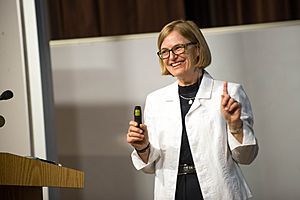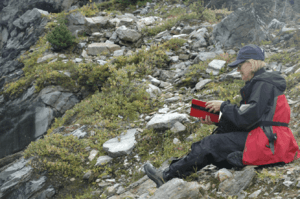Catherine Hickson facts for kids
Quick facts for kids
Catherine Hickson
|
|
|---|---|
 |
|
| Born | 1955 (age 69–70) |
| Nationality | Canadian |
| Other names | Cathie Hickson |
| Alma mater | University of British Columbia |
| Awards | Honorary Doctor of Technology - University of the Fraser Valley
C.J. Westerman Memorial Award 2023 Geoscientists Canada’s Canadian Professional Geoscientist Award |
| Scientific career | |
| Fields | Volcanology, geology, lithium exploration, geothermal energy |
| Institutions | TTGeo, Alberta No.1 |
| Thesis | Quaternary volcanism in the Wells Gray-Clearwater area, east central British Columbia (1987) |
Catherine Hickson (born 1955) is a Canadian volcanologist. A volcanologist is a scientist who studies volcanoes. She used to work for the Geological Survey of Canada. This is a part of Natural Resources Canada. Since 2014, she has been a chief operating officer for Dajin Resources Corp. She is also the president of Tuya Terra Geo Corp. Catherine Hickson studied at the University of British Columbia. She earned her PhD in geology and volcanology in 1987.
Contents
Catherine Hickson: Earth Explorer
Early Life and Education
Catherine Hickson grew up in Edmonton, Alberta. Her family often took trips to amazing natural places. These included Banff National Park, the Grand Canyon, and Yellowstone National Park. These trips showed her the wonders of nature, like geysers and volcanoes.
In 1980, when she was a student, something incredible happened. She was camping near Mount St. Helens when the volcano erupted! This powerful event changed her life. She decided to focus her career on volcanoes. She completed her first university degree in 1982. Then, she earned her PhD in 1987. Both degrees were from the University of British Columbia. For her PhD, she did field work in Wells Gray Provincial Park in British Columbia.
Working with the Canadian Government
Catherine Hickson spent 25 years working for the Government of Canada. She was part of the Geological Survey of Canada. Her early work focused on understanding volcanoes in Canada and around the world. She studied past eruptions and predicted future ones. She also looked at how volcanic hazards might affect people.
In 1998, she helped with a big emergency exercise. It was called Thunderbird III. This exercise imagined what would happen if Mount Baker in Washington state, USA, erupted. In 2003, she was one of three scientists who wrote a report. This report was about a possible eruption at Mount Cayley, a Canadian volcano.
Catherine also worked with the International Civil Aviation Organization. They created rules for planes flying near volcanic ash. She also helped create Canada's plan for volcanic eruptions. This plan is called the Interagency Volcanic Event Notification Plan (IVENP). It helps Canada respond if a volcano erupts nearby.
Working in the Energy Industry
In 2008, Catherine Hickson moved to the private sector. She joined Magma Energy Corp., a global energy company. By 2010, she became the Vice President of Exploration and Chief Geologist there. She learned a lot about geothermal energy. This is energy from the Earth's heat. She worked on projects in Chile, Iceland, Italy, Peru, and the USA.
After leaving Magma, she continued to work with geothermal energy. This involves using hot water and steam from inside the Earth. This energy can create electricity and heat.
In 2014, Catherine started her own company. It is called Tuya Terra Geo Corp.. This company helps with geothermal projects. It also helps explore for lithium. Lithium is a metal used in batteries. It is often found in areas with volcanic activity. Her company also helps teach the public about Earth sciences.
She also became a Director and Chief Operating Officer for Dajin Resources Corp. This company looks for lithium in salty water called lithium brines. These brines are found in places with volcanoes and geothermal systems.
In 2018, Catherine and other researchers restarted the Canadian Geothermal Association. It is now called Geothermal Canada. This group helps Canadian researchers and companies develop geothermal projects.
Today, Catherine is the CEO of the Alberta No.1 Geothermal Energy Project. This project is near Grande Prairie, Alberta. It will provide both electricity and heat to local industries.
International Work and Awards
Catherine Hickson's work has taken her all over the world. She spent a lot of time in South America. This area has some of the largest and highest volcanoes. She created and led a project called the Multinational Andean Project (MAP). This project ran from 1996 to 2002. It worked with Argentina, Bolivia, Chile, and Peru. The goal was to gather good geological data for finding resources.
A second project, Geoscience for Andean Communities (MAP: GAC), ran from 2002 to 2006. This project focused on making communities safer. It helped them prepare for natural hazards like volcanoes, earthquakes, and landslides. This project grew to include Ecuador, Colombia, and Venezuela.
Her international work earned her the C.J. Westerman Memorial Award in 2010. This award is from the Association of Professional Engineers and Geoscientists of British Columbia. She also received the Head of the Public Service Award in 1999. In 2015, she received an Honorary Doctorate of Technology from the University of the Fraser Valley.
Other Contributions
Catherine Hickson has written many books and articles. She has also given many talks and led field trips. She loves to share her knowledge with young people and the public. She wrote a book in 2005 about her experience at the 1980 eruption of Mount St. Helens. The book also explains how volcanoes erupt.

Catherine is a leader in Earth science. She is also a professor at the University of British Columbia. She helps mentor young women and managers.
One of her main interests is Wells Gray Provincial Park. She did her PhD research there in the 1980s. She has been involved with the park ever since. She leads trips and gives talks about the park's geology. She even tried to get it recognized as a World Heritage Site by UNESCO. She worked with Trevor Goward, a lichen expert, on this. Even though it wasn't chosen, they continue to support the park. It has amazing geology, plants, and animals. It is also home to endangered Mountain Caribou.
She is the president of the Wells Gray Wilderness Society. This group helps people learn about the park. They do field studies, workshops, and lectures. The society works with Thompson Rivers University. She is also on the board of the "Wells Gray Gateway Protection Society".
In 2018, Catherine led the first trip to explore Sarlacc's Pit cave. This is a newly found karst cave in the park. It is the largest of its kind. Catherine was contacted about this unusual cave because of her long history with Wells Gray Park. She co-wrote a book called "Nature Wells Gray" with Trevor Goward. She also wrote "Wells Gray Rocks" for the park's 75th anniversary.
Wells Gray Park Cave Discovery
Catherine was very important in understanding a newly discovered cave in Wells Gray Park. She was told about it in May 2018. She quickly realized it was probably not a volcanic feature. Instead, it was likely a karst cave. Karst caves form in soluble rocks like limestone.
Catherine contacted John Pollack, a cave expert. They knew each other through the Royal Canadian Geographical Society. She also reached out to BC Parks and local contacts to plan the exploration. Catherine and John wrote the permit application together. John also got help from other cavers. At the cave site in September 2018, Catherine studied the geology. She wanted to understand how the cave formed and how old it was. She continues to work with John and Lee to explore the cave further.
Notable Publications
Books
- Mt. St. Helens: Surviving the Stone Wind (2005)
- Nature Wells Gray: A visitor's guide to the park (2004)
- Nature Wells Gray: The Clearwater Valley (1989)
Articles
- Hickson, Catherine J., T. C. Spurgeon, and R. I. Tilling. (2013). "Eruption Types (Volcanic Eruptions)." Encyclopedia of Natural Hazards. Springer Netherlands, 2013. 290–293.
- Hickson, Catherine J. (2013). "Base Surge." Encyclopedia of Natural Hazards. Springer Netherlands. 41–42.
- Hickson C., Spurgeon T., Tilling, R., and Adam P. (2013) Factors Influencing Volcanic Hazards and the Morphology of Volcanic Landforms. In: John F. Shroder (ed.) Treatise on Geomorphology, Volume 13, pp. 219–242. San Diego: Academic Press.
- Stix, John, Glyn Williams-Jones, and Catherine Hickson. (2008). "Applying the COSPEC at active volcanoes." The COSPEC Cookbook: Making SO2 Measurements at Active Volcanoes, edited by: Williams-Jones, G., Stix, J., Hickson, C., IAVCEI, Methods in Volcanology 1: 121–167.
- Stasiuk, Mark V., Catherine J. Hickson, and Taimi Mulder. (2003). "The vulnerability of Canada to volcanic hazards." Natural hazards 28.2: 563–589.
- Getsinger, Jennifer S., and Catherine J. Hickson. (2000). "Multinational Andean Project (MAP): Geological co-operation across borders." Geoscience Canada 27.3
- Hickson, Catherine J., et al. (1995). "Intraglacial volcanism in the Wells Gray–Clearwater volcanic field, east-central British Columbia, Canada." Canadian Journal of Earth Sciences 32.7: 838–851.
- Hickson, Catherine J. (1994). "Volcanism in the Canadian Cordillera: Canada's hazard response preparedness." Volcanic ash and aviation safety: Proceedings of the first international symposium on volcanic ash and aviation safety: US Geological Survey Bulletin. Vol. 2047.

